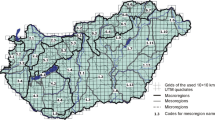Abstract
In ecology, one of the main interests is to understand species population dynamics and to describe its link with various environmental factors, such as habitat characteristics and climate. It is especially important to study the behaviour of animal species that can hosts pathogens, as they can be potential disease reservoirs and/or vectors. Pathogens of vector borne diseases can only be transmitted from an infected to a susceptible individual by a vector. Thus, vector ecology is a crucial factor influencing the transmission dynamics of vector borne diseases and their complexity. The formulation of models able to predict vector abundance are essential tools to implement intervention plans aiming to reduce the spread of vector-borne diseases (e.g. West Nile Virus). The goal of this paper is to explore the possible advantages in using Genetic Programming (GP) in the field of vector ecology. In this study, we present the application of GP to predict the distribution of Culex pipiens, a mosquito species vector of West Nile virus (WNV), in Piedmont, Italy. Our modelling approach took into consideration the ecological factors which affect mosquitoes abundance. Our results showed that GP was able to outperform a statistical model that was used to address the same problem in a previous work. Furthermore, GP performed an implicit feature selection, discovered automatically relationships among variables and produced fully explorable models.
Access this chapter
Tax calculation will be finalised at checkout
Purchases are for personal use only
Similar content being viewed by others
References
Diamond, M.S. (ed.): West Nile Encephalitis Virus Infection: Viral Pathogenesis and the Host Immune Response. Emerging Infectious Diseases of the 21st Century. Springer, New York (2009). https://doi.org/10.1007/978-0-387-79840-0
Chambers, T., Monath, T.: The Flaviviruses: Detection, Diagnosis and Vaccine Development. Advances in Virus Research. Elsevier Science, Amsterdam (2003). https://doi.org/10.1016/S0065-3527(03)61017-1
Sfakianos, J.N.: West Nile Virus. Chelsea House Publications, Langhorne (2005)
Kramer, L.D., Styer, L.M., Ebel, G.D.: A global perspective on the epidemiology of West Nile virus. Ann. Rev. Entomol. 53, 61–81 (2008). https://doi.org/10.1146/annurev.ento.53.103106.093258
Istituto Superiore di Sanità. http://old.iss.it/
Autorino, G.L., et al.: West Nile virus epidemic in horses, Tuscany region, Italy. Emerg. Infect. Dis. 8(12), 1372–1378 (2002). https://doi.org/10.3201/eid0812.020234
Ministero della Salute: Piano di sorveglianza nazionale per la encefalomielite di tipo West Nile (West Nile Disease). Gazzetta Ufficiale della Repubblica Italiana, N. 113, 16 May 2002
EpiCentro - Portale di epidemiologia. http://www.epicentro.iss.it/
Zeller, H.G., Schuffenecker, I.: West Nile virus: an overview of its spread in Europe and the Mediterranean basin in contrast to its spread in the Americas. Eur. J. Clin. Microbiol. Infect. Dis.: Off. Publ. Eur. Soc. Clin. Microbiol. 23(3), 147–156 (2004). https://doi.org/10.1007/s10096-003-1085-1
Becker, N., Jöst, A., Weitzel, T.: The Culex pipiens complex in Europe. J. Am. Mosq. Control Assoc. 28(4 Suppl.), 53–67 (2012). https://doi.org/10.2987/8756-971X-28.4s.53
Bisanzio, D., et al.: Spatio-temporal patterns of distribution of West Nile virus vectors in eastern Piedmont region, Italy. Parasites Vectors 4, 230 (2011). https://doi.org/10.1186/1756-3305-4-230
Arpa Piemonte. http://www.arpa.piemonte.it
NASA MODIS Web. https://modis.gsfc.nasa.gov/
Stroup, W.: Generalized Linear Mixed Models: Modern Concepts, Methods and Applications. CRC Press, Boca Raton (2012)
Spiegelhalter, D.J., Best, N.G., Carlin, B.P., Van-der Linde, A.: Bayesian measures of model complexity and fit. J. Roy. Stat. Soc. 64(4), 583–639 (2002). https://doi.org/10.1111/1467-9868.02022
Rue, H., Martino, S., Chopin, N.: Approximate Bayesian inference for latent Gaussian models by using integrated nested Laplace approximations. J. Roy. Stat. Soc.: Ser. B (Stat. Methodol.) 71(2), 319–392 (2009). https://doi.org/10.1111/j.1467-9868.2008.00700.x
Rosà, R., et al.: Early warning of West Nile virus mosquito vector: climate and land use models successfully explain phenology and abundance of Culex pipiens mosquitoes in north-western Italy. Parasites Vectors 7, 269 (2014). https://doi.org/10.1186/1756-3305-7-269
Koza, J.R.: Genetic Programming: On the Programming of Computers by Means of Natural Selection. MIT Press, Cambridge (1992)
Silva, S.: GPLAB - A Genetic Programming Toolbox for MATLAB. http://gplab.sourceforge.net/index.html
Luke, S., Panait, L.: Lexicographic parsimony pressure. In: Proceedings of the 4th Annual Conference on Genetic and Evolutionary Computation, GECCO 2002, pp. 829–836. Morgan Kaufmann Publishers Inc., San Francisco (2002)
Vargha, A., Delaney, H.D.: A critique and improvement of the “CL" common language effect size statistics of McGraw and Wong. J. Educ. Behav. Stat. 25(2), 101–132 (2000). https://doi.org/10.2307/1165329
A vectorial approach to genetic programming. Submitted to EuroGP 2019
Poli, R., Langdon, W., McPhee, N., Koza, J.: A Field Guide to Genetic Programming. Lulu.com, Morrisville (2008). https://doi.org/10.1007/s10710-008-9073-y
Author information
Authors and Affiliations
Corresponding author
Editor information
Editors and Affiliations
Rights and permissions
Copyright information
© 2019 Springer Nature Switzerland AG
About this paper
Cite this paper
Gervasi, R., Azzali, I., Bisanzio, D., Mosca, A., Bertolotti, L., Giacobini, M. (2019). A Genetic Programming Approach to Predict Mosquitoes Abundance. In: Sekanina, L., Hu, T., Lourenço, N., Richter, H., García-Sánchez, P. (eds) Genetic Programming. EuroGP 2019. Lecture Notes in Computer Science(), vol 11451. Springer, Cham. https://doi.org/10.1007/978-3-030-16670-0_3
Download citation
DOI: https://doi.org/10.1007/978-3-030-16670-0_3
Published:
Publisher Name: Springer, Cham
Print ISBN: 978-3-030-16669-4
Online ISBN: 978-3-030-16670-0
eBook Packages: Computer ScienceComputer Science (R0)




